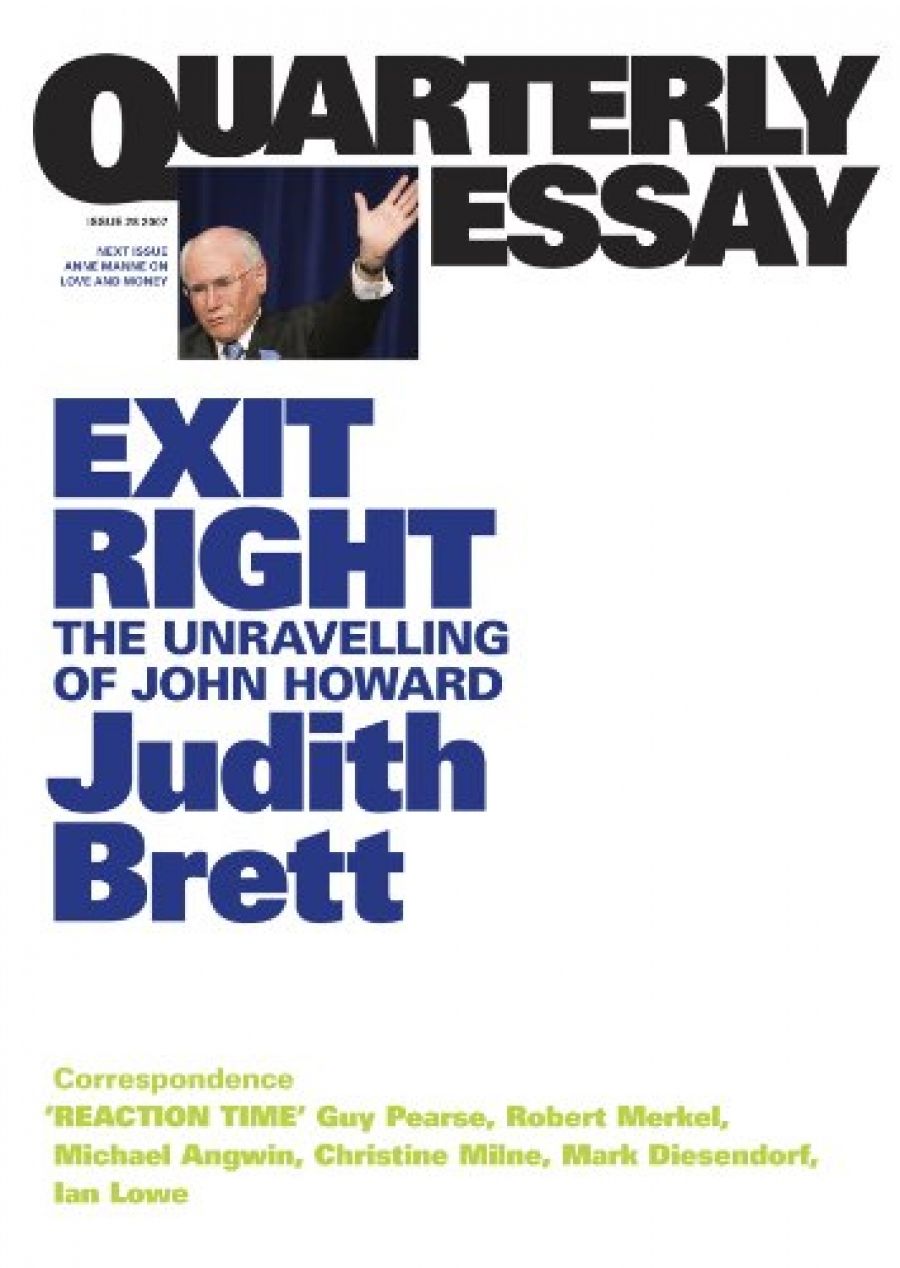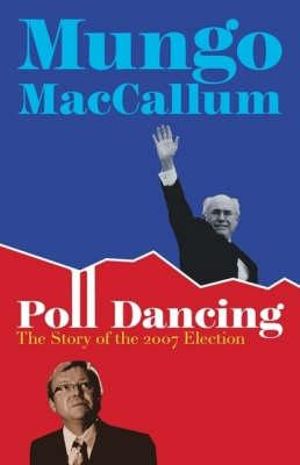
- Free Article: No
- Contents Category: Politics
- Review Article: Yes
- Online Only: No
- Custom Highlight Text:
Since the November federal election, kicking John Howard while he’s down has become something of a national pastime. While Howard’s take no-prisoners-except-on-Nauru behaviour has now exposed him to gleeful mass taunting, the idea that the end of his resilient political career has instantly created a noble Australia, its citizens and institutions cleansed and renew ed, is wishful thinking. In this context, Judith Brett’s new Quarterly Essay injects some welcome clear-headedness. Brett rains blows on Howard, but she is not a Howard-hater in the counterproductive and grandiose style of, say, Phillip Adams. Instead, she takes aim at the former prime minister in a characteristically nuanced and astute way. She bridges a gap – too often in Australia, a gulf – between scholars and interested laypeople, offering prose that is accessible and lively but that avoids dumbing down complex issues.
- Book 1 Title: Exit Right
- Book 1 Subtitle: The unravelling of John Howard (Quarterly Essay 28)
- Book 1 Biblio: Black Inc., $14.95 pb, 124 pp
- Book 2 Title: Poll Dancing
- Book 2 Subtitle: The story of the 2007 election
- Book 2 Biblio: Black Inc., $24.95 pb, 298 pp
- Book 2 Cover Small (400 x 600):

- Book 2 Cover (800 x 1200):

- Book 2 Cover Path (no longer required): images/1_SocialMedia/2021/September_2021/META/poll-dancing.jpg
That is not to say that Brett is miraculously neutral or that all her pronouncements are inevitably true or profound. There is nothing startling about her assessment of the Howard legacy: he has left the Liberal party in a mess and the nation with a booming economy but unprepared to confront global warming and other serious environmental challenges. Similarly, Brett’s identification of individual issues that blighted Howard – Work Choices, his age, the Liberal’s rigid set of policies, the messy succession plan, Kevin Rudd’s freshness, rising interest rates – is unremarkable. Yet Brett’s big-picture approach, and her steady tone, transforms the debate over the Howard governments’ perceived successes and failures, demanding that the nation – as well as the man – take ownership of the last eleven years.
Brett’s writing is distinguished by the historical and political contexts that she weaves into her narrative, including the structural flaws of federalism, the history and motivations of the Liberal Party, and the nature of Australia’s version of the Westminster system. Notably, Brett thinks that any discussion of the Liberal Party must also involve the Australian Labor Party. While she has previously noted that this does not necessarily endear her to some Liberal true believers – see Relaxed and Comfortable: The Liberal Party’s Australia (Quarterly Essay 19, 2005) – conversely she shows that a central plank of Howard’s re-election strategy was to demonise Rudd as a man and as an economic manager. Brett also aligns herself with James Walter and Paul Strangio, whose No, Prime Minister: Reclaiming Politics from Leaders (2007) is a persuasive but wooden essay in which the authors suggest, among other things, that the progressively deleterious concentration of power in the prime ministerial office since the Whitlam era has been exacerbated by Howard’s style of leadership in the ‘war on terror’ era.
The core of Exit Right: The Unravelling of John Howard is Brett’s analysis of the nature of leadership in a liberal democracy. Brett argues that Howard began ‘unravelling’ the day that Rudd replaced Kim Beazley as the Labor leader in December 2006. This implies that Howard’s eventual defeat was contingent not only on changed national and international circumstances, and on the Coalition’s policy blunders and political excesses, but also on the timbre of Rudd and on Howard’s incapacity to reinvent himself as Labor set about successfully wooing the electorate. Brett observes: ‘It is when a leader’s grip on political power starts to slip, when his threats and bribes miss their mark, when he starts to make uncharacteristic mistakes and when what had once been strengths reveal their limitations, that we can see most clearly the inner workings of that leadership.’ But in noting that an individual’s political motivation involves a genuine desire to serve and to push a set of ideals, as well as to grab power, Brett accepts that Howard truly believed he remained the Liberal Party’s, and the country’s, best leader.
Brett incorporates Graham Little’s psychosocial theory on types of leadership (see Political Ensembles: A Psychosocial Approach to Politics and Leadership, 1985), defining Howard as a Strong Leader (in Little’s pantheon there also exist group leaders and inspiring leaders). A Strong Leader, Brett says, is ‘hardworking, tough and alert … He demands total loyalty from the group, using his strength not just to combat the enemy but to stare down any internal opposition.’ She cites the Tampa controversy as an example of an issue that suited Howard the Strong Leader: ‘A minor external threat was turned into a crisis which quickly escalated into a test of the leader’s strength which Howard then had to win at all costs or lose credibility.’ In contrast, Brett suggests that Howard’s global warming scepticism, and his tunnel vision economy-comes-first rhetoric, is an ex ample of a Strong Leader unable or unwilling to respond to an issue that requires ‘cooperation, an open, inquiring mind and new ideas’.
Brett argues that Howard, despite his professed interest in the things that unite rather than divide Australians, thrived on division and created battles that could produce only winners and losers (the war allusions are deliberate). Whereas Beazley (post-Latham) responded to Howard’s attacks on him by attempting to defend himself, Rudd refused to play along: ‘It takes two to have a fight, and with Rudd refusing to fight on the government’s terms, Howard and the government seemed more and more like men boxing with an enemy who was the projection of their own ideological imaginations.’ In 2007 Howard’s strengths became weaknesses, as the electorate rejected the ‘you’re with us or you’re against us’ style of leadership that had so appealed post9/11. Meanwhile, Rudd quickly proved to be a more energetic, nimble and engaged leader than Beazley. More than that, Rudd’s refusal to be a warrior like Paul Keating or Mark Latham shows that Rudd, like Brett, was an assiduous student of Howard’s politicking.
Maxine McKew represented another sort of challenge again for Howard, forcing him to campaign in Bennelong with a level of civility to which he was entirely unsuited. McKew, like Rudd, clearly understood Howard. She took full advantage of the Bennelong redistribution and of Andrew Wilkie’s efforts in the 2004 election, yet Brett seems uncharacteristically starry-eyed when she says, ‘For McKew, politics is not so much about winning and losing as about communication’. McKew is refreshing, and her achievement considerable, but it remains an utter mystery what sort of politician – as opposed to campaigner – she will be.
Exit Right reinforces Brett’s standing as an authoritative contemporary commentator on the Liberal Party and its place within Australian society. It offers a measured examination, though at times a fierce denunciation, of Howard’s last months as prime minister. But there is also a sense that Brett is merely putting her toe in the water prior to commencing the sort of detailed assessment of the Howard years that will help us to grasp the good and the bad reasons why the electorate for so long rewarded and celebrated our own Strong Leader.
Although it is a much longer book, veteran journalist Mungo MacCallum’s Poll Dancing: The Story of the 2007 Election seems a little thin alongside Brett’s Exit Right. MacCallum lets himself off the hook when he writes, ‘Poll Dancing was always intended as a personal memoir rather than as a definitive history, and while I have tried to be as accurate as possible on the facts, the opinions should be treated as strictly impressionistic.’ This implies that MacCallum’s idle thoughts, his larrikinism and his wit, along with the theatricality of the politics itself, will sustain interest. In combination they do, but only up to a point.
MacCallum’s opening premise is that the election campaign effectively ran from the moment Rudd defeated Beazley. Accordingly, MacCallum’s diarising of the election campaign proper does not begin until page 246, and his analysis of it is cursory and rather distracted. Still, the chronological account of 2007 builds a dramatic picture – to follow MacCallum’s dancing metaphor – of a leaden footed Coalition desperately trying to keep time with the electorate. In retrospect, the Coalition’s hopelessness is palpable. Like Brett, MacCallum shows how adept Rudd was at changing the questions asked of him to suit himself (although this is a too-celebrated trait in winning politicians).
In the context of this battle of ideas – but mainly, seemingly, the battle to wedge or to avoid being wedged – MacCallum’s observations can be funny. He takes aim at every body, though Alexander Downer is a favourite target. Occasionally, MacCallum marries his savage wit with quite insightful observations, adding substance to the one-liners. But more often – for instance, Downer on the Australian Wheat Board, Downer on Iraq – he plays his observations for laughs. It is unsubtle, and the aggressive edge to MacCallum’s insults become somewhat wearying and predictable. To scratch the surface of the political process is to ex pose a wealth of political shenanigans and tail-wagging-dog behaviour, some of which is clearly mendacious but much of which is individuals and groups trying to find a way to fix a problem or pursue an idea. Poll Dancing’s day-to-day account of politics is automatically satirical. Think of Kevin Andrews, victim of a new departmental acronym, becoming a DIC-head. Or as MacCallum says about Howard’s ludicrous efforts to infiltrate YouTube, ‘Some things defy parody’. But even as MacCallum pounds the Coalition and the mainstream media – particularly the Australian’s Denis Shanahan – for profoundly misunderstanding the mood of the electorate, his focus on the media-driven political agenda ultimately validates the ‘a-headline-a-day’ approach to politics. In contrast, Brett notes that by the time Howard called the election, ‘No one was listening, except for the members of the press gallery, who still had to fill columns and columns of comment and speculation, and political junkies like me, who read whatever they write.’
Poll Dancing is fun and thoughtful at times, but given MacCallum’s experience and individuality, and given the material he had to work with, it is also something of a disappointment. He begins each chapter with a dancing-themed epigraph. The pick of them is Angela Monet’s quote: ‘Those who danced were thought to be quite insane by those who could not hear the music.’ MacCallum himself hears the music of politics very well indeed, and even as he invents his own moves, he seems to revel in all the noise.


Comments powered by CComment